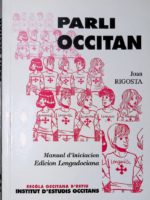Un article de Jordi Serra-Cobo, deth Departament de Biologica Evolutiva, Ecologia i Ciències Ambientals dera Facultat de Biologia dera Universitat de Barcelona.
Institut de Recerca de la Biodiversitat (IRBIO).
Un article de Jordi Serra-Cobo, deth Departament de Biologica Evolutiva, Ecologia i Ciències Ambientals dera Facultat de Biologia dera Universitat de Barcelona.
Institut de Recerca de la Biodiversitat (IRBIO).
| Categories: | Divulgacion, Estudis e monografics |
|---|---|
| Tags: | aranés, estudis, monografics |
| book-author | |
|---|---|
| format |

Per toti es publicacions
Pes libres en format papèr
En lengua occitana
Tòn equipa ath tòn servici
This book offers a general introduction to the world of the troubadours. Its sixteen chapters, newly commissioned from leading scholars in Britain, the United States, France, Italy and Spain, trace the development of troubadour song (including music), engage with the main trends in troubadour scholarship, and examine the reception of troubadour poetry in manuscripts and in Northern French romance. A series of appendices offer an invaluable guide to more than fifty troubadours, to technical vocabulary, to research tools and to surviving manuscripts.
I a pògues causes en lenguatge que donguen tanta escadença ara creativitat com era toponímia. Es colors, es formes, era vegetacion deth territòri; es nòms o es maunòms des sòns estatjants; ua istòria, un avodament, ua legenda o un equipament… quina causa que sigue barrejada damb er engenh dera gent servís entà generar un toponim.
Pr’amor d’açò, es nòms de lòc mos diden plen de causes sus es abitants, sus es origines o sus era natura de cada endret e son capables de crear un trincadís de colors plan variats que balhe personalitat a cada cornèr deth país.
Mès es toponims son tanben informacion, descripcion precisa, coordenada exacta enes mapes, nomenclators urbans, bases de donades o guides. Son un element indispensable de guidatge e de referéncia sus un territòri plen de persones en movement.
Aguesti dus aspèctes son es qu’an encoratjat ara Comission de Toponímia de Catalonha tà aufrir as municipis e tà toti es qu’agen de trabalhar damb nòms de lòc, uns Critèris que mos an de perméter preservar plan viua era riquesa culturau qu’era toponímia represente e adobar-la entà hèr-la utila.
Aran ath long dera sua millenària existéncia a anat configurant ua simbologia pròpia, uns senhaus d’identitat, ua istòria e un patrimòni d’identificacion collectiua.
Auem er escut qu’ei reflèxe e expression dea nòsta istòria. Sintèssis de toti es elements: Lengua, Istòria, Art, Territòri e Volentat collectiua; Diuersitat e convivéncia. Er escut sintetise toti aguesti element d’arraötz popular e eth pòble les identifique coma pròpis.
Angel Claveria a sabut articular tot eth contengut simbolic en aguestes quate planes, Mos cau emplegar e mantier es simbèus entà permanéisher coma pòble.
Montaillou: un petit village de montagnards et de bergers en haute Auriège, à 1 300 mètres d’altitude. En 1320, Jacques Fournier, évêque de Pamiers, plus tard pape d’Avignon, y déploie ses talents d’inquisiteur. Il finit par déterrer tous les secrets du village.
Rien n’échappe à cet évêque fureteur, ni les vies intimes, ni les drames de l’existence quotidienne.
En s’appuyant sur cet extraordinaire document de Jacques Fournier, sorte de roman vrai du petit peuple du XIV siècle, Emmanuel Le Roy Ladurie ressuscite, en utilisant les méthodes historiques et ethnographiques les plus actuelles, la réalité occitane et cathare d’il y a six cent cinquante ans.
An edition and translation of some 30 poems by the trobairditz, a remarkable group of women poets from the 12th and 13th centuries, who composed in the style and language of the troubadours.
Era publicacion deth Nomenclator dera Val d’Aran represente ua hita importanta ena normalizacion des sòns nòms de lòc der aranés e, donques, dera lengua madeisha. Ei un esturment basic de consulta entara Administracion e eth mon empresariau entà designar, etiquetar e fixar es nòms de lòc de manèra normativa.
Aguest nomenclator permet era localizacion dera toponimia aranesa en ua cartografia de detalh, a on practicament toti es nòms de lòc d’Aran son recuelhuts e tanben normalizadi. Atau, eth Nomenclator dera Val d’Aran amasse un totau de 3 450 toponims de tot tipe que provien dera Basa toponimica a escala 1:5000 der Institut Cartografic e Geologic de Catalonha (ICGC), era mès detalhada que corbís actuaument tota era Val d’Aran.
Era òbra qu’auetz enes mans ei frut d’un convèni de collaboracion entre er Institut d’Estudi Aranesi-Acadèmia aranesa dera lengua occitana, coma autoritat lingüistica dera lengua occitana en Catalonha, e er Institut Cartografic e Geologic de Catalonha, coma generador de cartografia e d’informacion geografica.
Eth nau Nomenclator ei un esturment de referéncia que contribuirà, d’un costast, ara coneishença e era difusion des formes adequades des nòms de lòc e era sua localizacion sus eth territòri e, der aute, ara preservacion dera toponimia coma auviatge intangible, coma testimòni des eveniments istorics e coma reflèxe d’ua cultura viua que contunharà evolucionant.

Be the first to review “Es arrates-caudes dera Val d’Aran”
You must be logged in to post a review.